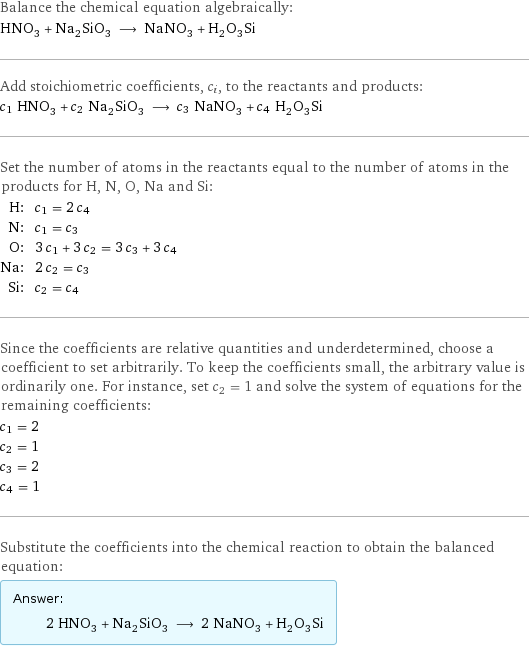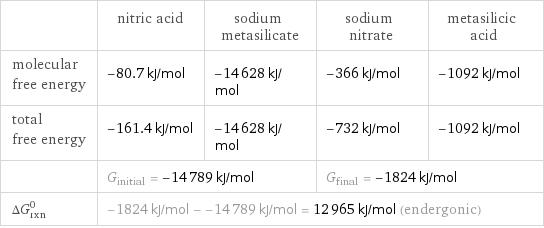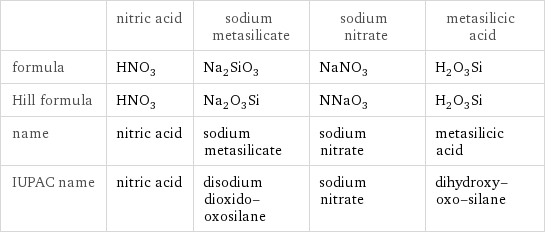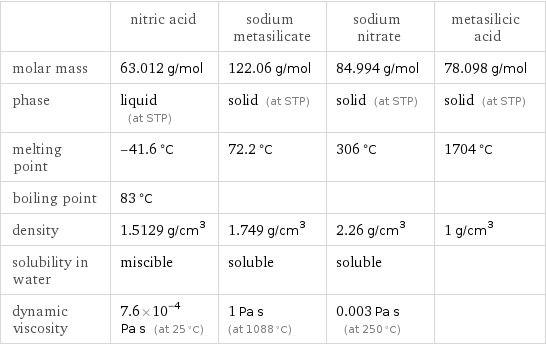Input interpretation

HNO_3 nitric acid + Na_2SiO_3 sodium metasilicate ⟶ NaNO_3 sodium nitrate + H_2O_3Si metasilicic acid
Balanced equation

Balance the chemical equation algebraically: HNO_3 + Na_2SiO_3 ⟶ NaNO_3 + H_2O_3Si Add stoichiometric coefficients, c_i, to the reactants and products: c_1 HNO_3 + c_2 Na_2SiO_3 ⟶ c_3 NaNO_3 + c_4 H_2O_3Si Set the number of atoms in the reactants equal to the number of atoms in the products for H, N, O, Na and Si: H: | c_1 = 2 c_4 N: | c_1 = c_3 O: | 3 c_1 + 3 c_2 = 3 c_3 + 3 c_4 Na: | 2 c_2 = c_3 Si: | c_2 = c_4 Since the coefficients are relative quantities and underdetermined, choose a coefficient to set arbitrarily. To keep the coefficients small, the arbitrary value is ordinarily one. For instance, set c_2 = 1 and solve the system of equations for the remaining coefficients: c_1 = 2 c_2 = 1 c_3 = 2 c_4 = 1 Substitute the coefficients into the chemical reaction to obtain the balanced equation: Answer: | | 2 HNO_3 + Na_2SiO_3 ⟶ 2 NaNO_3 + H_2O_3Si
Structures

+ ⟶ +
Names

nitric acid + sodium metasilicate ⟶ sodium nitrate + metasilicic acid
Reaction thermodynamics
Gibbs free energy

| nitric acid | sodium metasilicate | sodium nitrate | metasilicic acid molecular free energy | -80.7 kJ/mol | -14628 kJ/mol | -366 kJ/mol | -1092 kJ/mol total free energy | -161.4 kJ/mol | -14628 kJ/mol | -732 kJ/mol | -1092 kJ/mol | G_initial = -14789 kJ/mol | | G_final = -1824 kJ/mol | ΔG_rxn^0 | -1824 kJ/mol - -14789 kJ/mol = 12965 kJ/mol (endergonic) | | |
Equilibrium constant
![Construct the equilibrium constant, K, expression for: HNO_3 + Na_2SiO_3 ⟶ NaNO_3 + H_2O_3Si Plan: • Balance the chemical equation. • Determine the stoichiometric numbers. • Assemble the activity expression for each chemical species. • Use the activity expressions to build the equilibrium constant expression. Write the balanced chemical equation: 2 HNO_3 + Na_2SiO_3 ⟶ 2 NaNO_3 + H_2O_3Si Assign stoichiometric numbers, ν_i, using the stoichiometric coefficients, c_i, from the balanced chemical equation in the following manner: ν_i = -c_i for reactants and ν_i = c_i for products: chemical species | c_i | ν_i HNO_3 | 2 | -2 Na_2SiO_3 | 1 | -1 NaNO_3 | 2 | 2 H_2O_3Si | 1 | 1 Assemble the activity expressions accounting for the state of matter and ν_i: chemical species | c_i | ν_i | activity expression HNO_3 | 2 | -2 | ([HNO3])^(-2) Na_2SiO_3 | 1 | -1 | ([Na2SiO3])^(-1) NaNO_3 | 2 | 2 | ([NaNO3])^2 H_2O_3Si | 1 | 1 | [H2O3Si] The equilibrium constant symbol in the concentration basis is: K_c Mulitply the activity expressions to arrive at the K_c expression: Answer: | | K_c = ([HNO3])^(-2) ([Na2SiO3])^(-1) ([NaNO3])^2 [H2O3Si] = (([NaNO3])^2 [H2O3Si])/(([HNO3])^2 [Na2SiO3])](../image_source/7ba640ff5e14be266f6e55c1beb8c2d3.png)
Construct the equilibrium constant, K, expression for: HNO_3 + Na_2SiO_3 ⟶ NaNO_3 + H_2O_3Si Plan: • Balance the chemical equation. • Determine the stoichiometric numbers. • Assemble the activity expression for each chemical species. • Use the activity expressions to build the equilibrium constant expression. Write the balanced chemical equation: 2 HNO_3 + Na_2SiO_3 ⟶ 2 NaNO_3 + H_2O_3Si Assign stoichiometric numbers, ν_i, using the stoichiometric coefficients, c_i, from the balanced chemical equation in the following manner: ν_i = -c_i for reactants and ν_i = c_i for products: chemical species | c_i | ν_i HNO_3 | 2 | -2 Na_2SiO_3 | 1 | -1 NaNO_3 | 2 | 2 H_2O_3Si | 1 | 1 Assemble the activity expressions accounting for the state of matter and ν_i: chemical species | c_i | ν_i | activity expression HNO_3 | 2 | -2 | ([HNO3])^(-2) Na_2SiO_3 | 1 | -1 | ([Na2SiO3])^(-1) NaNO_3 | 2 | 2 | ([NaNO3])^2 H_2O_3Si | 1 | 1 | [H2O3Si] The equilibrium constant symbol in the concentration basis is: K_c Mulitply the activity expressions to arrive at the K_c expression: Answer: | | K_c = ([HNO3])^(-2) ([Na2SiO3])^(-1) ([NaNO3])^2 [H2O3Si] = (([NaNO3])^2 [H2O3Si])/(([HNO3])^2 [Na2SiO3])
Rate of reaction
![Construct the rate of reaction expression for: HNO_3 + Na_2SiO_3 ⟶ NaNO_3 + H_2O_3Si Plan: • Balance the chemical equation. • Determine the stoichiometric numbers. • Assemble the rate term for each chemical species. • Write the rate of reaction expression. Write the balanced chemical equation: 2 HNO_3 + Na_2SiO_3 ⟶ 2 NaNO_3 + H_2O_3Si Assign stoichiometric numbers, ν_i, using the stoichiometric coefficients, c_i, from the balanced chemical equation in the following manner: ν_i = -c_i for reactants and ν_i = c_i for products: chemical species | c_i | ν_i HNO_3 | 2 | -2 Na_2SiO_3 | 1 | -1 NaNO_3 | 2 | 2 H_2O_3Si | 1 | 1 The rate term for each chemical species, B_i, is 1/ν_i(Δ[B_i])/(Δt) where [B_i] is the amount concentration and t is time: chemical species | c_i | ν_i | rate term HNO_3 | 2 | -2 | -1/2 (Δ[HNO3])/(Δt) Na_2SiO_3 | 1 | -1 | -(Δ[Na2SiO3])/(Δt) NaNO_3 | 2 | 2 | 1/2 (Δ[NaNO3])/(Δt) H_2O_3Si | 1 | 1 | (Δ[H2O3Si])/(Δt) (for infinitesimal rate of change, replace Δ with d) Set the rate terms equal to each other to arrive at the rate expression: Answer: | | rate = -1/2 (Δ[HNO3])/(Δt) = -(Δ[Na2SiO3])/(Δt) = 1/2 (Δ[NaNO3])/(Δt) = (Δ[H2O3Si])/(Δt) (assuming constant volume and no accumulation of intermediates or side products)](../image_source/649e02f55bc663bbbde8634ca5edecbf.png)
Construct the rate of reaction expression for: HNO_3 + Na_2SiO_3 ⟶ NaNO_3 + H_2O_3Si Plan: • Balance the chemical equation. • Determine the stoichiometric numbers. • Assemble the rate term for each chemical species. • Write the rate of reaction expression. Write the balanced chemical equation: 2 HNO_3 + Na_2SiO_3 ⟶ 2 NaNO_3 + H_2O_3Si Assign stoichiometric numbers, ν_i, using the stoichiometric coefficients, c_i, from the balanced chemical equation in the following manner: ν_i = -c_i for reactants and ν_i = c_i for products: chemical species | c_i | ν_i HNO_3 | 2 | -2 Na_2SiO_3 | 1 | -1 NaNO_3 | 2 | 2 H_2O_3Si | 1 | 1 The rate term for each chemical species, B_i, is 1/ν_i(Δ[B_i])/(Δt) where [B_i] is the amount concentration and t is time: chemical species | c_i | ν_i | rate term HNO_3 | 2 | -2 | -1/2 (Δ[HNO3])/(Δt) Na_2SiO_3 | 1 | -1 | -(Δ[Na2SiO3])/(Δt) NaNO_3 | 2 | 2 | 1/2 (Δ[NaNO3])/(Δt) H_2O_3Si | 1 | 1 | (Δ[H2O3Si])/(Δt) (for infinitesimal rate of change, replace Δ with d) Set the rate terms equal to each other to arrive at the rate expression: Answer: | | rate = -1/2 (Δ[HNO3])/(Δt) = -(Δ[Na2SiO3])/(Δt) = 1/2 (Δ[NaNO3])/(Δt) = (Δ[H2O3Si])/(Δt) (assuming constant volume and no accumulation of intermediates or side products)
Chemical names and formulas

| nitric acid | sodium metasilicate | sodium nitrate | metasilicic acid formula | HNO_3 | Na_2SiO_3 | NaNO_3 | H_2O_3Si Hill formula | HNO_3 | Na_2O_3Si | NNaO_3 | H_2O_3Si name | nitric acid | sodium metasilicate | sodium nitrate | metasilicic acid IUPAC name | nitric acid | disodium dioxido-oxosilane | sodium nitrate | dihydroxy-oxo-silane
Substance properties

| nitric acid | sodium metasilicate | sodium nitrate | metasilicic acid molar mass | 63.012 g/mol | 122.06 g/mol | 84.994 g/mol | 78.098 g/mol phase | liquid (at STP) | solid (at STP) | solid (at STP) | solid (at STP) melting point | -41.6 °C | 72.2 °C | 306 °C | 1704 °C boiling point | 83 °C | | | density | 1.5129 g/cm^3 | 1.749 g/cm^3 | 2.26 g/cm^3 | 1 g/cm^3 solubility in water | miscible | soluble | soluble | dynamic viscosity | 7.6×10^-4 Pa s (at 25 °C) | 1 Pa s (at 1088 °C) | 0.003 Pa s (at 250 °C) |
Units
